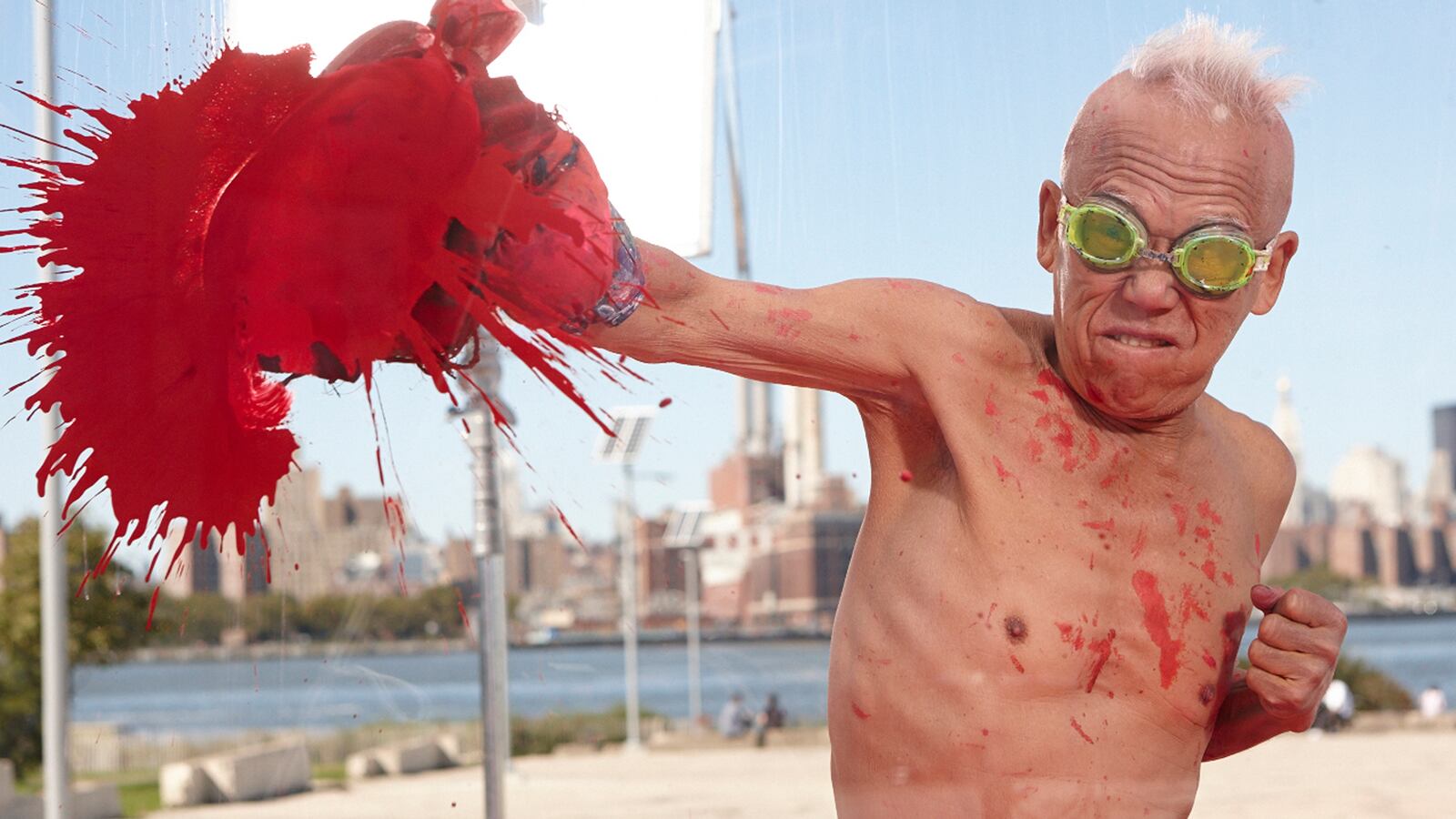In 1972, a 19-year-old art student named Noriko left Tokyo for New York and wandered into a SoHo studio, where she met 41-year-old artist Ushio Shinohara. The morning after they first had sex, he asked if he could borrow rent money. She wrote him a check.

Six months later, she was in love, pregnant, and, as her furious parents cut her off, destitute. It was not the beginning of a fairy tale.
Marriage for Ushio and Noriko Shinohara is an ongoing conflict between bitterness, sacrifice and fierce devotion that first-time director Zachary Heinzerling portrays without sugar-coating in his Oscar-nominated documentary, Cutie and the Boxer. The film follows the couple through their tumultuous history and focuses on Noriko as she finally gains recognition for her art. Frustrations and old resentments don’t evaporate under Heinzerling’s lens, but the resulting portrait of a long-term relationship is real and more touching than any Hollywood script.
“When I first met [the Shinoharas], I was just struck by the raw spirit and beauty that emanates from their faces, their lifestyle, their art, everything about them has so much purpose and character,” says Heinzerling. “Even if you don’t speak Japanese, even if you have no previous knowledge of their artwork or who they are, you’re immediately captivated by their presence. They live in a world that’s kind of a time warp that hearkens back to the ‘70s New York SoHo art scene that is sort of canonized in history, certainly from my point of view.”
Ushio was an art world celebrity in Japan during the avant-garde period of the ‘60s, but his cardboard junk sculptures and signature boxing paintings rarely sell in America. In a clip from a 1979 documentary, Ushio is called “the most famous of the poor and struggling artists in New York.” Now 82 years old, with four decades of prestigious exhibitions and accolades behind him (and a few photos with Andy Warhol in his stash), Ushio still sometimes struggles to pay the rent.
Noriko’s own ambitions were put on hold while she raised their son and Ushio made art. “The fact that she stopped going to school and started working with me was the best move in order for her to become a good artist,” Ushio tells me through a translator. To hear him tell it, Noriko chose marriage, knowing that life influences art more than education does. “For artists, your private life takes a big role in what you create,” he says. “Especially with the type of art that we make.”
Noriko, however, is having none of it.
“I couldn’t continue school because of the financial problems. All the money my parents sent us was spent on his rent,” she says (in English). “That was my worst time. After I met him, I became like naked. All my ideas, all my freshness, he took away.”
(This is said, mind you, as the two sit right next to each other.)
“Complicated” is the simplest way to describe the Shinoharas’ marriage. In Cutie and the Boxer, for every barb thrown at Ushio for being a bad husband, Noriko is also seen joking with him, helping him with his art, and lending a critical eye and constructive advice. Ushio, in turn, clearly loves his Noriko, even as he continues to underestimate her, at one point telling the camera, “The average one has to support the genius.” Like most marriages, it’s sometimes chaotic and always interesting—which, of course, makes for great art.
Noriko’s “Cutie and Bullie” drawings are the paper product of her “terrible experiences,” featuring stylized versions of herself (“Cutie”) and Ushio (“Bullie”). In the pictures, we see their first date and the birth of their son, Alex. Cutie runs after Bullie with a baby in her arms, as he shouts behind him, “Don’t bother my freedom!” She cleans up after his late-night partying and navigates their lives around his alcoholism. But eventually, Cutie takes on a life of her own. “She conquers Bullie,” Noriko says. We see a drawing of Cutie, happily sitting on Bullie’s back as he looks up at her, small red hearts surrounding them both. “In real life,” Noriko admits, “it’s not so easy.”
In the film, with the spotlight on her for the first time, Noriko sets up a parallel exhibition alongside Ushio’s monstrous cardboard sculptures and his signature boxing pieces, created by attaching foam rubber pads to boxing gloves and punching a length of canvas. Somewhat unexpectedly, hordes of gallery goers are attracted to Noriko’s drawings. Strangers compliment her. A star is born and Ushio looks just a little bit jealous. (He admits, even now, that he was disappointed upon first watching Cutie and the Boxer—he had expected the film to be about his art, not his wife.)
Noriko, of course, couldn’t be happier. After the film’s first theatrical run last August, people began asking when they’d be able to see the entire “Cutie and Bullie” series. Noriko proudly informs me that a book is ready and waiting for a publisher.
“It took 35 years for me to find Cutie on my own,” Noriko says. “My life has been bitter and difficult. But without that bitterness, as I told you in the film, my Cutie [wouldn’t have been] born.”
Cutie and Bullie get happy endings, but Noriko and Ushio still live in reality. After more than 40 years together, the Shinoharas’ relationship is as chaotic as ever—and they know they won’t ever change. When asked if he still thinks of Noriko as the “average one” whose role is to support the “genius,” Ushio says, “One thing that’s clear is that I do need an assistant so there’s no choice, I have to ask Noriko to be an assistant. But if you think about it, art supply stores sell supplies to geniuses…I think that the act of creating things, only a select group of people can do it.”
Noriko, sensing that she’s the art supply store in this analogy, quickly counters. “Art supplies are not free,” she says, making Heinzerling and her husband’s translator laugh.
The film and its director have earned numerous awards and nominations over the past year, including the Sundance Film Festival’s Best Director Award. On March 2, it’ll go for the biggest prize of all: A Best Feature Documentary Academy Award. For Heinzerling, it couldn’t be more gratifying.
“On paper, it was always difficult to sell the film,” he says. “A smaller film with a first-time director about artists that are relatively unknown. But I think the film has really stood because it’s about marriage and the creative process and long-term relationships and sacrifices. All the good and bad that comes with it. It’s a very universal story.”






